Interview with Sean Healey Head of Issuing Product North America at Wirecard and Pyments.com
Inertia is a powerful force in the world of payments and commerce, and one that explains the persistence of things that seem like they should have been disrupted long ago. Paper checks, the biweekly pay cycle, contact-based payments — the technology has long existed to banish those antiquated ideas and replace them with a digitized variation that is faster, smoother, more accessible and more secure. And yet the anachronisms persist — or at least they did, until about a month ago.
The emergence of COVID-19, Wirecard Head of Issuing Product North America Sean Healey told PYMNTS in a recent conversation, reset the entire payments and commerce landscape in a breathtakingly swift fashion. Several older forms of technology persisted not because they were particularly good or beloved so much as they were familiar. In the post-coronavirus landscape, however, things like checks just don’t work at all. Consumers are experimenting with entirely new modes of interaction — and learning that there are a lot of better ways to conduct their daily financial lives.
And those ways will still be better even after the active pandemic has passed, he noted, as consumers go about restructuring their lives, but not necessarily resetting them back to what they once were.
“I think COVID-19 has changed the way businesses and consumers think about payments and every level of and type of interaction — from shopping to eating out to working and beyond. I think we have areas where adoption has generally been slow where we’re certainly going to see a major uptick that won’t ever go back to the way they were,” Healey said.
And it won’t just be a lot of “out with the old” on display in a post-COVID-19 world — but a lot of “in with the new,” which would have seemed impossibly futuristic as recently as six months ago.
Reorienting The Marketplace
Check-based disbursements are the best example of a persistent payment method that may, at long last, be ready for retirement in the wake of COVID-19. Checks have mostly stayed around on the strength of being familiar, Healey noted, even if they brought little else to the table.
Today, they simply aren’t adequate for the needs of the market — printing, cutting and handling checks is a hassle for firms that have gone remote and also presents a public health risk. And as firms are finally ready to move past the check, he said, other innovations become possible for the workers for whom they are most critically relevant.
“When workers are no longer waiting for checks to clear, that opens up the potential to be paid more frequently — that traditional biweekly timeframe can go out the window if it needs to,” Healey said.
For businesses that aim to either boost employee satisfaction or help employees improve their cash flow, having those options readily available is very important. And, Healey added, the rapid shift to a digital-only world has pushed consumers into a host of experiences that have thus before now been slower to ignite in the U.S. market. His list is extensive: contactless payments, mobile wallet adoption and use, mobile app-based shopping, grocery delivery and curbside pickup.
The trendlines before the coronavirus pandemic were already driving up in all of those areas — but there were still wide swaths of consumers who were reluctant to explore an upgrade when what they had been using was still functional, if not optimal. The pandemic has changed that menu of choices, and compelled consumers to try products and services they may have been hesitant to experiment with in the past.
“Consumers are going to encounter the innovations and realize a digital disbursement is better than a check, it’s better to click a link to pay than to do so in person, it’s easier to order online than to search in a store,” Healey said. “I was rarely using grocery curbside pickup before. If it isn’t an option now, that shop is no longer even in the ballgame for me going forward.”
And that readiness for change won’t just eliminate what’s out of date, but will also open the door for what’s next.
The Brighter Digital Future
Predicting what will follow in the post-COVID-19 world is incredibly challenging, given that the situation is still unfolding and developing in real time. There will be all kinds of interesting things to watch for, Healey said. Dining and shopping experiences will now be highly omnichannel going forward, as consumers will restrict activities to their home, particularly in the phased transitional period out of social distancing, he noted.
For merchants and retailers everywhere, being able to sell online will be critical no matter what business they are in, because consumers’ transactional lives will be more digitally anchored from here on out.
But the most interesting changes, Healey said, are the ones that aren’t yet in focus, but that will be enabled by consumers who have now lived a digital-only life and have created new routines and expectations. What that will mean is still an emerging picture, but the possibilities are wide — and in some cases, long-anticipated.
“I think all of this will pave the way for things like smart cities, which seemed like such futuristic ideas even a couple of years ago,” said Healey. “With our society now better prepared to adapt to changes and respond in an agile fashion, I think there are a lot of amazing things we will be able to do together.”
